Security Challenges in Emerging Networks
VerifiedAdded on 2023/06/07
|9
|2775
|162
AI Summary
This report discusses the security challenges in emerging networks, with a focus on healthcare networks. It includes a literature review, analysis of potential security issues, and threat mitigation techniques.
Contribute Materials
Your contribution can guide someone’s learning journey. Share your
documents today.
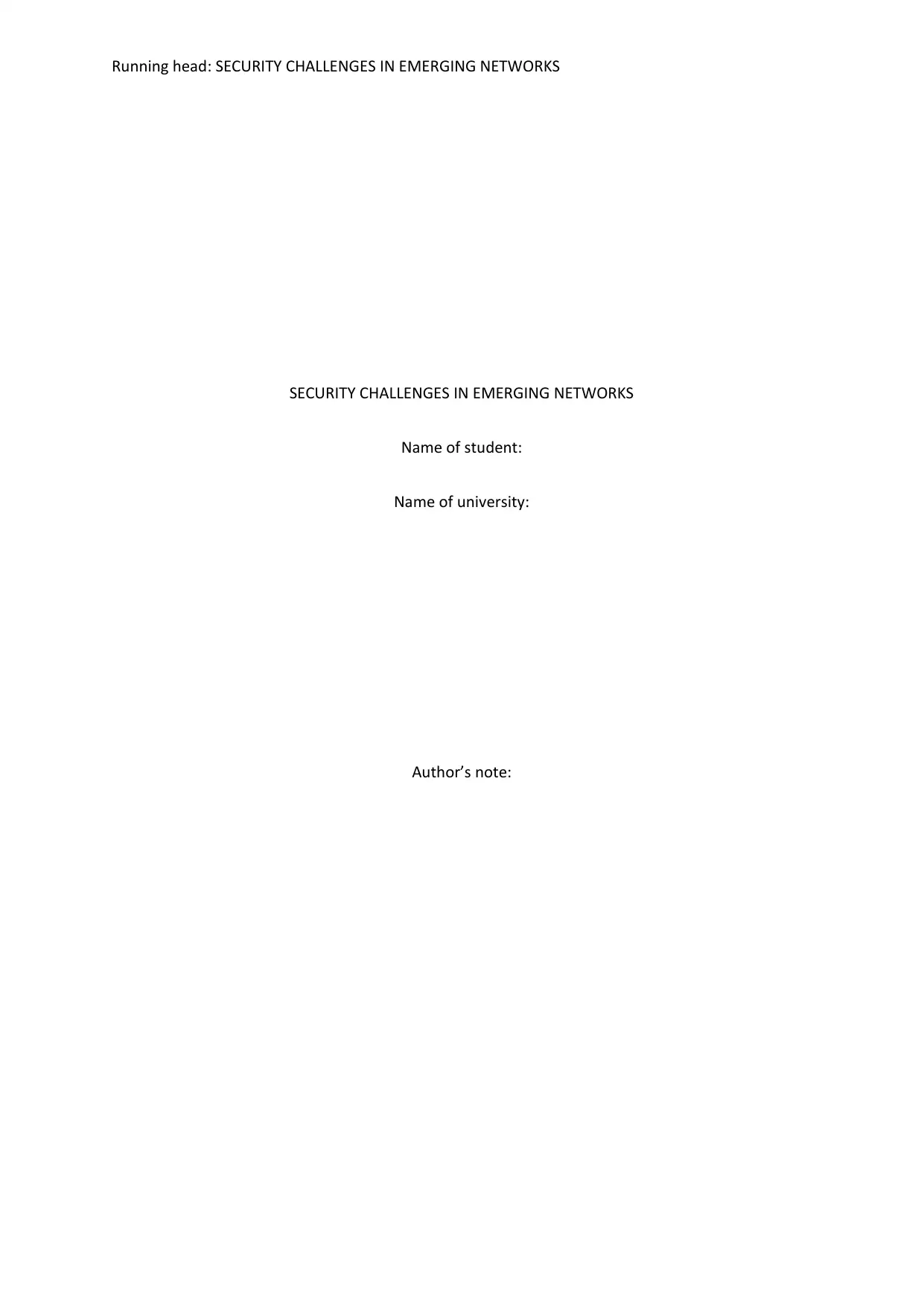
Running head: SECURITY CHALLENGES IN EMERGING NETWORKS
SECURITY CHALLENGES IN EMERGING NETWORKS
Name of student:
Name of university:
Author’s note:
SECURITY CHALLENGES IN EMERGING NETWORKS
Name of student:
Name of university:
Author’s note:
Secure Best Marks with AI Grader
Need help grading? Try our AI Grader for instant feedback on your assignments.
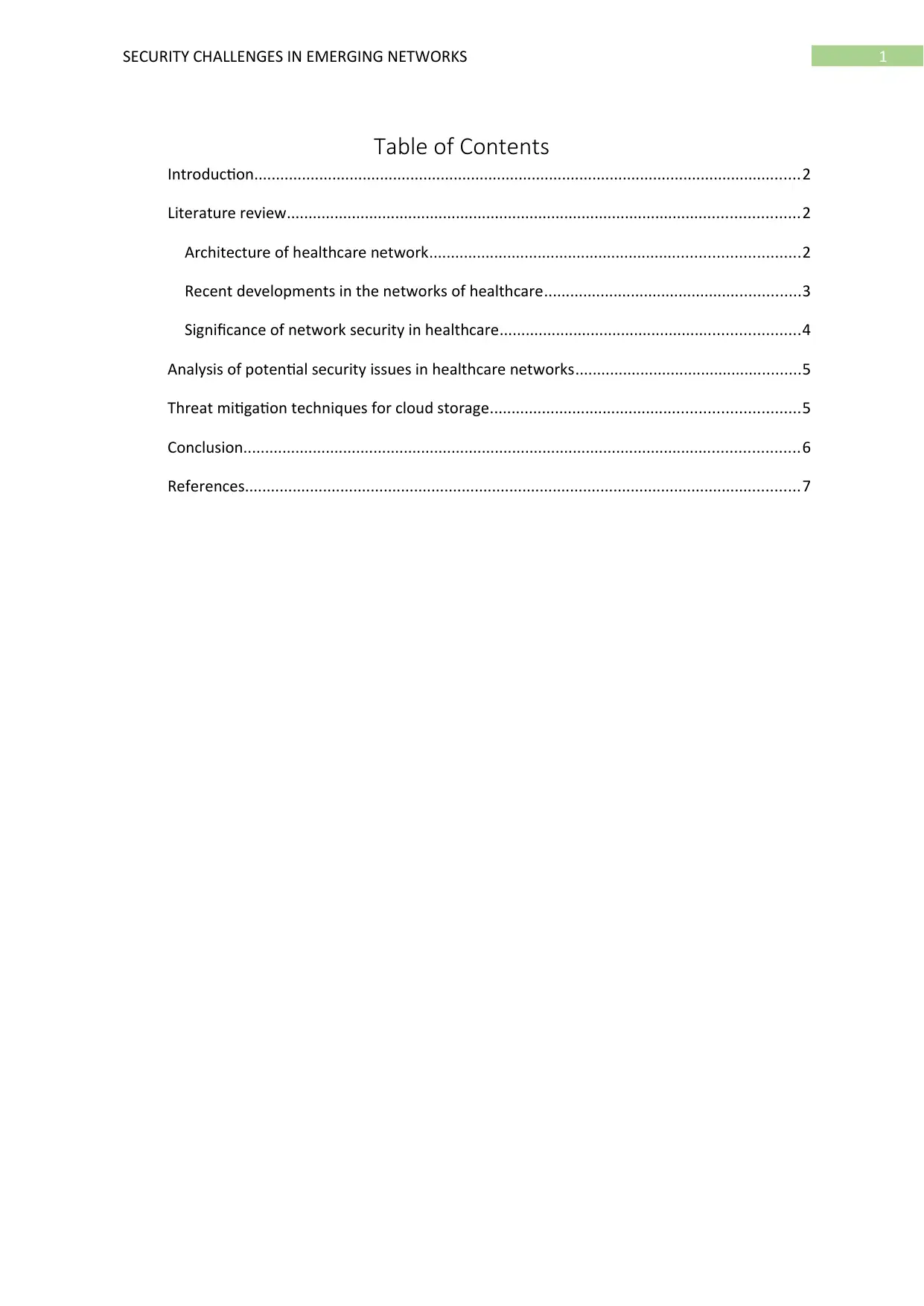
1SECURITY CHALLENGES IN EMERGING NETWORKS
Table of Contents
Introduction..............................................................................................................................2
Literature review......................................................................................................................2
Architecture of healthcare network.....................................................................................2
Recent developments in the networks of healthcare...........................................................3
Significance of network security in healthcare.....................................................................4
Analysis of potential security issues in healthcare networks....................................................5
Threat mitigation techniques for cloud storage.......................................................................5
Conclusion................................................................................................................................6
References................................................................................................................................7
Table of Contents
Introduction..............................................................................................................................2
Literature review......................................................................................................................2
Architecture of healthcare network.....................................................................................2
Recent developments in the networks of healthcare...........................................................3
Significance of network security in healthcare.....................................................................4
Analysis of potential security issues in healthcare networks....................................................5
Threat mitigation techniques for cloud storage.......................................................................5
Conclusion................................................................................................................................6
References................................................................................................................................7
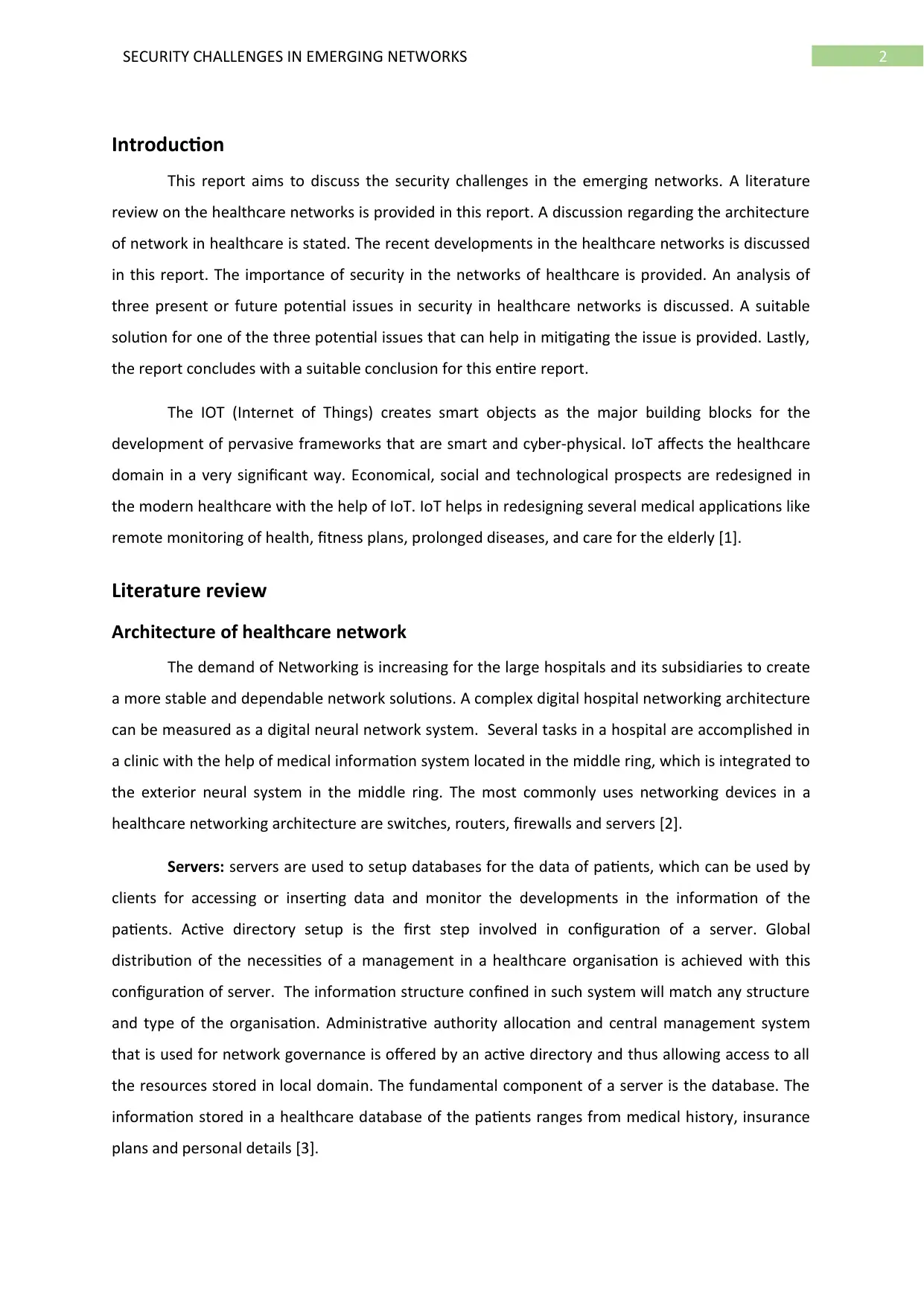
2SECURITY CHALLENGES IN EMERGING NETWORKS
Introduction
This report aims to discuss the security challenges in the emerging networks. A literature
review on the healthcare networks is provided in this report. A discussion regarding the architecture
of network in healthcare is stated. The recent developments in the healthcare networks is discussed
in this report. The importance of security in the networks of healthcare is provided. An analysis of
three present or future potential issues in security in healthcare networks is discussed. A suitable
solution for one of the three potential issues that can help in mitigating the issue is provided. Lastly,
the report concludes with a suitable conclusion for this entire report.
The IOT (Internet of Things) creates smart objects as the major building blocks for the
development of pervasive frameworks that are smart and cyber-physical. IoT affects the healthcare
domain in a very significant way. Economical, social and technological prospects are redesigned in
the modern healthcare with the help of IoT. IoT helps in redesigning several medical applications like
remote monitoring of health, fitness plans, prolonged diseases, and care for the elderly [1].
Literature review
Architecture of healthcare network
The demand of Networking is increasing for the large hospitals and its subsidiaries to create
a more stable and dependable network solutions. A complex digital hospital networking architecture
can be measured as a digital neural network system. Several tasks in a hospital are accomplished in
a clinic with the help of medical information system located in the middle ring, which is integrated to
the exterior neural system in the middle ring. The most commonly uses networking devices in a
healthcare networking architecture are switches, routers, firewalls and servers [2].
Servers: servers are used to setup databases for the data of patients, which can be used by
clients for accessing or inserting data and monitor the developments in the information of the
patients. Active directory setup is the first step involved in configuration of a server. Global
distribution of the necessities of a management in a healthcare organisation is achieved with this
configuration of server. The information structure confined in such system will match any structure
and type of the organisation. Administrative authority allocation and central management system
that is used for network governance is offered by an active directory and thus allowing access to all
the resources stored in local domain. The fundamental component of a server is the database. The
information stored in a healthcare database of the patients ranges from medical history, insurance
plans and personal details [3].
Introduction
This report aims to discuss the security challenges in the emerging networks. A literature
review on the healthcare networks is provided in this report. A discussion regarding the architecture
of network in healthcare is stated. The recent developments in the healthcare networks is discussed
in this report. The importance of security in the networks of healthcare is provided. An analysis of
three present or future potential issues in security in healthcare networks is discussed. A suitable
solution for one of the three potential issues that can help in mitigating the issue is provided. Lastly,
the report concludes with a suitable conclusion for this entire report.
The IOT (Internet of Things) creates smart objects as the major building blocks for the
development of pervasive frameworks that are smart and cyber-physical. IoT affects the healthcare
domain in a very significant way. Economical, social and technological prospects are redesigned in
the modern healthcare with the help of IoT. IoT helps in redesigning several medical applications like
remote monitoring of health, fitness plans, prolonged diseases, and care for the elderly [1].
Literature review
Architecture of healthcare network
The demand of Networking is increasing for the large hospitals and its subsidiaries to create
a more stable and dependable network solutions. A complex digital hospital networking architecture
can be measured as a digital neural network system. Several tasks in a hospital are accomplished in
a clinic with the help of medical information system located in the middle ring, which is integrated to
the exterior neural system in the middle ring. The most commonly uses networking devices in a
healthcare networking architecture are switches, routers, firewalls and servers [2].
Servers: servers are used to setup databases for the data of patients, which can be used by
clients for accessing or inserting data and monitor the developments in the information of the
patients. Active directory setup is the first step involved in configuration of a server. Global
distribution of the necessities of a management in a healthcare organisation is achieved with this
configuration of server. The information structure confined in such system will match any structure
and type of the organisation. Administrative authority allocation and central management system
that is used for network governance is offered by an active directory and thus allowing access to all
the resources stored in local domain. The fundamental component of a server is the database. The
information stored in a healthcare database of the patients ranges from medical history, insurance
plans and personal details [3].
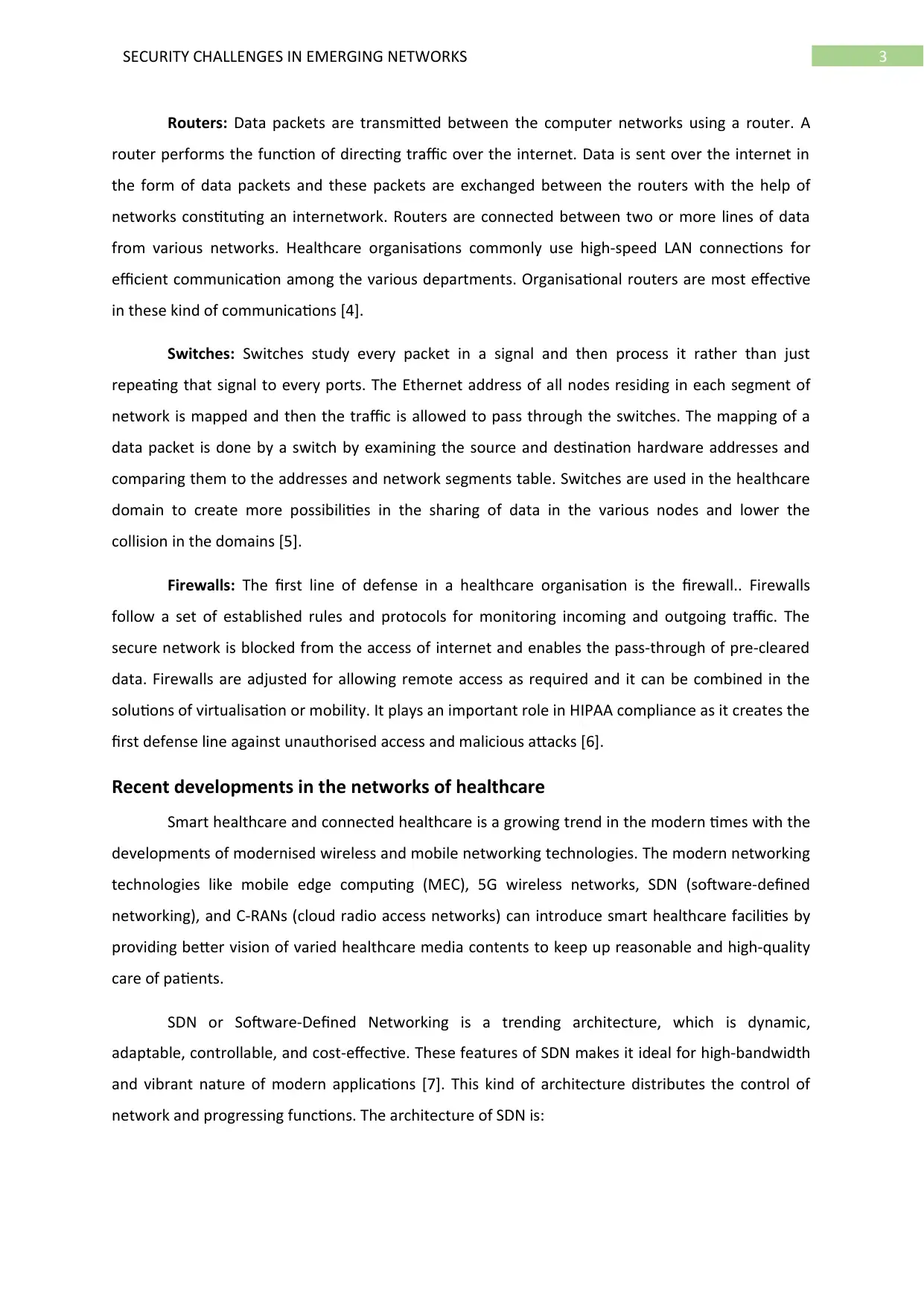
3SECURITY CHALLENGES IN EMERGING NETWORKS
Routers: Data packets are transmitted between the computer networks using a router. A
router performs the function of directing traffic over the internet. Data is sent over the internet in
the form of data packets and these packets are exchanged between the routers with the help of
networks constituting an internetwork. Routers are connected between two or more lines of data
from various networks. Healthcare organisations commonly use high-speed LAN connections for
efficient communication among the various departments. Organisational routers are most effective
in these kind of communications [4].
Switches: Switches study every packet in a signal and then process it rather than just
repeating that signal to every ports. The Ethernet address of all nodes residing in each segment of
network is mapped and then the traffic is allowed to pass through the switches. The mapping of a
data packet is done by a switch by examining the source and destination hardware addresses and
comparing them to the addresses and network segments table. Switches are used in the healthcare
domain to create more possibilities in the sharing of data in the various nodes and lower the
collision in the domains [5].
Firewalls: The first line of defense in a healthcare organisation is the firewall.. Firewalls
follow a set of established rules and protocols for monitoring incoming and outgoing traffic. The
secure network is blocked from the access of internet and enables the pass-through of pre-cleared
data. Firewalls are adjusted for allowing remote access as required and it can be combined in the
solutions of virtualisation or mobility. It plays an important role in HIPAA compliance as it creates the
first defense line against unauthorised access and malicious attacks [6].
Recent developments in the networks of healthcare
Smart healthcare and connected healthcare is a growing trend in the modern times with the
developments of modernised wireless and mobile networking technologies. The modern networking
technologies like mobile edge computing (MEC), 5G wireless networks, SDN (software-defined
networking), and C-RANs (cloud radio access networks) can introduce smart healthcare facilities by
providing better vision of varied healthcare media contents to keep up reasonable and high-quality
care of patients.
SDN or Software-Defined Networking is a trending architecture, which is dynamic,
adaptable, controllable, and cost-effective. These features of SDN makes it ideal for high-bandwidth
and vibrant nature of modern applications [7]. This kind of architecture distributes the control of
network and progressing functions. The architecture of SDN is:
Routers: Data packets are transmitted between the computer networks using a router. A
router performs the function of directing traffic over the internet. Data is sent over the internet in
the form of data packets and these packets are exchanged between the routers with the help of
networks constituting an internetwork. Routers are connected between two or more lines of data
from various networks. Healthcare organisations commonly use high-speed LAN connections for
efficient communication among the various departments. Organisational routers are most effective
in these kind of communications [4].
Switches: Switches study every packet in a signal and then process it rather than just
repeating that signal to every ports. The Ethernet address of all nodes residing in each segment of
network is mapped and then the traffic is allowed to pass through the switches. The mapping of a
data packet is done by a switch by examining the source and destination hardware addresses and
comparing them to the addresses and network segments table. Switches are used in the healthcare
domain to create more possibilities in the sharing of data in the various nodes and lower the
collision in the domains [5].
Firewalls: The first line of defense in a healthcare organisation is the firewall.. Firewalls
follow a set of established rules and protocols for monitoring incoming and outgoing traffic. The
secure network is blocked from the access of internet and enables the pass-through of pre-cleared
data. Firewalls are adjusted for allowing remote access as required and it can be combined in the
solutions of virtualisation or mobility. It plays an important role in HIPAA compliance as it creates the
first defense line against unauthorised access and malicious attacks [6].
Recent developments in the networks of healthcare
Smart healthcare and connected healthcare is a growing trend in the modern times with the
developments of modernised wireless and mobile networking technologies. The modern networking
technologies like mobile edge computing (MEC), 5G wireless networks, SDN (software-defined
networking), and C-RANs (cloud radio access networks) can introduce smart healthcare facilities by
providing better vision of varied healthcare media contents to keep up reasonable and high-quality
care of patients.
SDN or Software-Defined Networking is a trending architecture, which is dynamic,
adaptable, controllable, and cost-effective. These features of SDN makes it ideal for high-bandwidth
and vibrant nature of modern applications [7]. This kind of architecture distributes the control of
network and progressing functions. The architecture of SDN is:
Secure Best Marks with AI Grader
Need help grading? Try our AI Grader for instant feedback on your assignments.
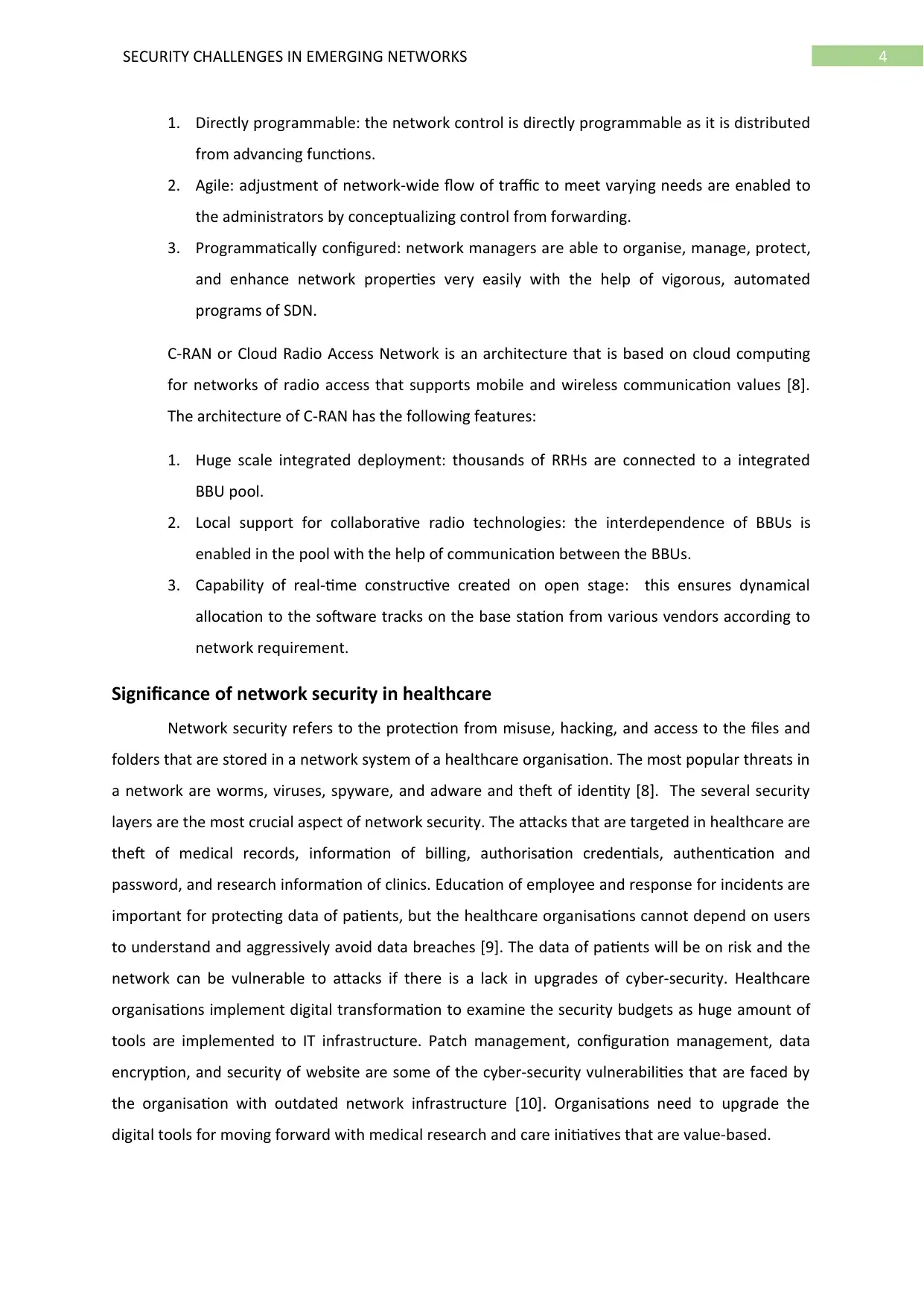
4SECURITY CHALLENGES IN EMERGING NETWORKS
1. Directly programmable: the network control is directly programmable as it is distributed
from advancing functions.
2. Agile: adjustment of network-wide flow of traffic to meet varying needs are enabled to
the administrators by conceptualizing control from forwarding.
3. Programmatically configured: network managers are able to organise, manage, protect,
and enhance network properties very easily with the help of vigorous, automated
programs of SDN.
C-RAN or Cloud Radio Access Network is an architecture that is based on cloud computing
for networks of radio access that supports mobile and wireless communication values [8].
The architecture of C-RAN has the following features:
1. Huge scale integrated deployment: thousands of RRHs are connected to a integrated
BBU pool.
2. Local support for collaborative radio technologies: the interdependence of BBUs is
enabled in the pool with the help of communication between the BBUs.
3. Capability of real-time constructive created on open stage: this ensures dynamical
allocation to the software tracks on the base station from various vendors according to
network requirement.
Significance of network security in healthcare
Network security refers to the protection from misuse, hacking, and access to the files and
folders that are stored in a network system of a healthcare organisation. The most popular threats in
a network are worms, viruses, spyware, and adware and theft of identity [8]. The several security
layers are the most crucial aspect of network security. The attacks that are targeted in healthcare are
theft of medical records, information of billing, authorisation credentials, authentication and
password, and research information of clinics. Education of employee and response for incidents are
important for protecting data of patients, but the healthcare organisations cannot depend on users
to understand and aggressively avoid data breaches [9]. The data of patients will be on risk and the
network can be vulnerable to attacks if there is a lack in upgrades of cyber-security. Healthcare
organisations implement digital transformation to examine the security budgets as huge amount of
tools are implemented to IT infrastructure. Patch management, configuration management, data
encryption, and security of website are some of the cyber-security vulnerabilities that are faced by
the organisation with outdated network infrastructure [10]. Organisations need to upgrade the
digital tools for moving forward with medical research and care initiatives that are value-based.
1. Directly programmable: the network control is directly programmable as it is distributed
from advancing functions.
2. Agile: adjustment of network-wide flow of traffic to meet varying needs are enabled to
the administrators by conceptualizing control from forwarding.
3. Programmatically configured: network managers are able to organise, manage, protect,
and enhance network properties very easily with the help of vigorous, automated
programs of SDN.
C-RAN or Cloud Radio Access Network is an architecture that is based on cloud computing
for networks of radio access that supports mobile and wireless communication values [8].
The architecture of C-RAN has the following features:
1. Huge scale integrated deployment: thousands of RRHs are connected to a integrated
BBU pool.
2. Local support for collaborative radio technologies: the interdependence of BBUs is
enabled in the pool with the help of communication between the BBUs.
3. Capability of real-time constructive created on open stage: this ensures dynamical
allocation to the software tracks on the base station from various vendors according to
network requirement.
Significance of network security in healthcare
Network security refers to the protection from misuse, hacking, and access to the files and
folders that are stored in a network system of a healthcare organisation. The most popular threats in
a network are worms, viruses, spyware, and adware and theft of identity [8]. The several security
layers are the most crucial aspect of network security. The attacks that are targeted in healthcare are
theft of medical records, information of billing, authorisation credentials, authentication and
password, and research information of clinics. Education of employee and response for incidents are
important for protecting data of patients, but the healthcare organisations cannot depend on users
to understand and aggressively avoid data breaches [9]. The data of patients will be on risk and the
network can be vulnerable to attacks if there is a lack in upgrades of cyber-security. Healthcare
organisations implement digital transformation to examine the security budgets as huge amount of
tools are implemented to IT infrastructure. Patch management, configuration management, data
encryption, and security of website are some of the cyber-security vulnerabilities that are faced by
the organisation with outdated network infrastructure [10]. Organisations need to upgrade the
digital tools for moving forward with medical research and care initiatives that are value-based.
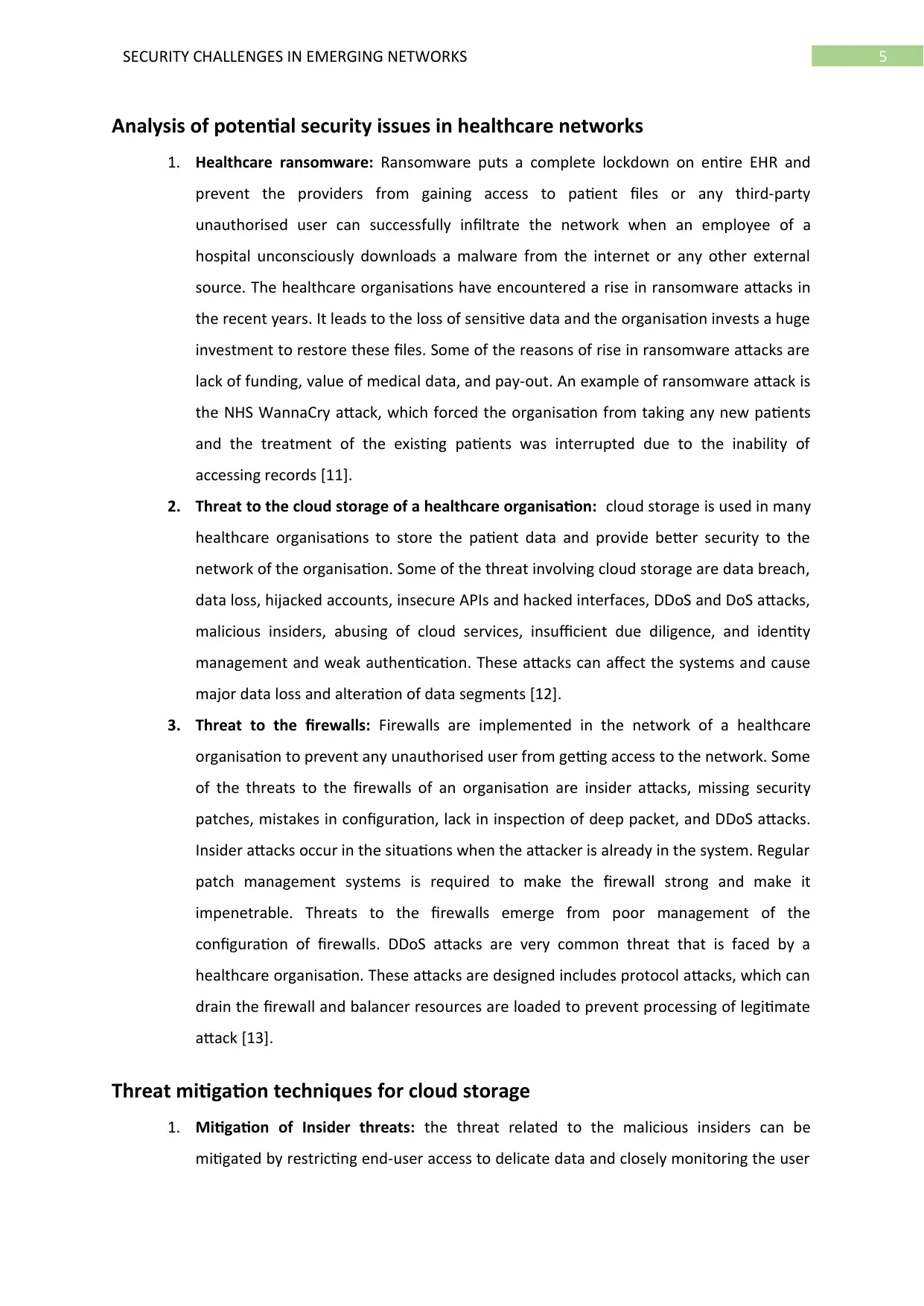
5SECURITY CHALLENGES IN EMERGING NETWORKS
Analysis of potential security issues in healthcare networks
1. Healthcare ransomware: Ransomware puts a complete lockdown on entire EHR and
prevent the providers from gaining access to patient files or any third-party
unauthorised user can successfully infiltrate the network when an employee of a
hospital unconsciously downloads a malware from the internet or any other external
source. The healthcare organisations have encountered a rise in ransomware attacks in
the recent years. It leads to the loss of sensitive data and the organisation invests a huge
investment to restore these files. Some of the reasons of rise in ransomware attacks are
lack of funding, value of medical data, and pay-out. An example of ransomware attack is
the NHS WannaCry attack, which forced the organisation from taking any new patients
and the treatment of the existing patients was interrupted due to the inability of
accessing records [11].
2. Threat to the cloud storage of a healthcare organisation: cloud storage is used in many
healthcare organisations to store the patient data and provide better security to the
network of the organisation. Some of the threat involving cloud storage are data breach,
data loss, hijacked accounts, insecure APIs and hacked interfaces, DDoS and DoS attacks,
malicious insiders, abusing of cloud services, insufficient due diligence, and identity
management and weak authentication. These attacks can affect the systems and cause
major data loss and alteration of data segments [12].
3. Threat to the firewalls: Firewalls are implemented in the network of a healthcare
organisation to prevent any unauthorised user from getting access to the network. Some
of the threats to the firewalls of an organisation are insider attacks, missing security
patches, mistakes in configuration, lack in inspection of deep packet, and DDoS attacks.
Insider attacks occur in the situations when the attacker is already in the system. Regular
patch management systems is required to make the firewall strong and make it
impenetrable. Threats to the firewalls emerge from poor management of the
configuration of firewalls. DDoS attacks are very common threat that is faced by a
healthcare organisation. These attacks are designed includes protocol attacks, which can
drain the firewall and balancer resources are loaded to prevent processing of legitimate
attack [13].
Threat mitigation techniques for cloud storage
1. Mitigation of Insider threats: the threat related to the malicious insiders can be
mitigated by restricting end-user access to delicate data and closely monitoring the user
Analysis of potential security issues in healthcare networks
1. Healthcare ransomware: Ransomware puts a complete lockdown on entire EHR and
prevent the providers from gaining access to patient files or any third-party
unauthorised user can successfully infiltrate the network when an employee of a
hospital unconsciously downloads a malware from the internet or any other external
source. The healthcare organisations have encountered a rise in ransomware attacks in
the recent years. It leads to the loss of sensitive data and the organisation invests a huge
investment to restore these files. Some of the reasons of rise in ransomware attacks are
lack of funding, value of medical data, and pay-out. An example of ransomware attack is
the NHS WannaCry attack, which forced the organisation from taking any new patients
and the treatment of the existing patients was interrupted due to the inability of
accessing records [11].
2. Threat to the cloud storage of a healthcare organisation: cloud storage is used in many
healthcare organisations to store the patient data and provide better security to the
network of the organisation. Some of the threat involving cloud storage are data breach,
data loss, hijacked accounts, insecure APIs and hacked interfaces, DDoS and DoS attacks,
malicious insiders, abusing of cloud services, insufficient due diligence, and identity
management and weak authentication. These attacks can affect the systems and cause
major data loss and alteration of data segments [12].
3. Threat to the firewalls: Firewalls are implemented in the network of a healthcare
organisation to prevent any unauthorised user from getting access to the network. Some
of the threats to the firewalls of an organisation are insider attacks, missing security
patches, mistakes in configuration, lack in inspection of deep packet, and DDoS attacks.
Insider attacks occur in the situations when the attacker is already in the system. Regular
patch management systems is required to make the firewall strong and make it
impenetrable. Threats to the firewalls emerge from poor management of the
configuration of firewalls. DDoS attacks are very common threat that is faced by a
healthcare organisation. These attacks are designed includes protocol attacks, which can
drain the firewall and balancer resources are loaded to prevent processing of legitimate
attack [13].
Threat mitigation techniques for cloud storage
1. Mitigation of Insider threats: the threat related to the malicious insiders can be
mitigated by restricting end-user access to delicate data and closely monitoring the user
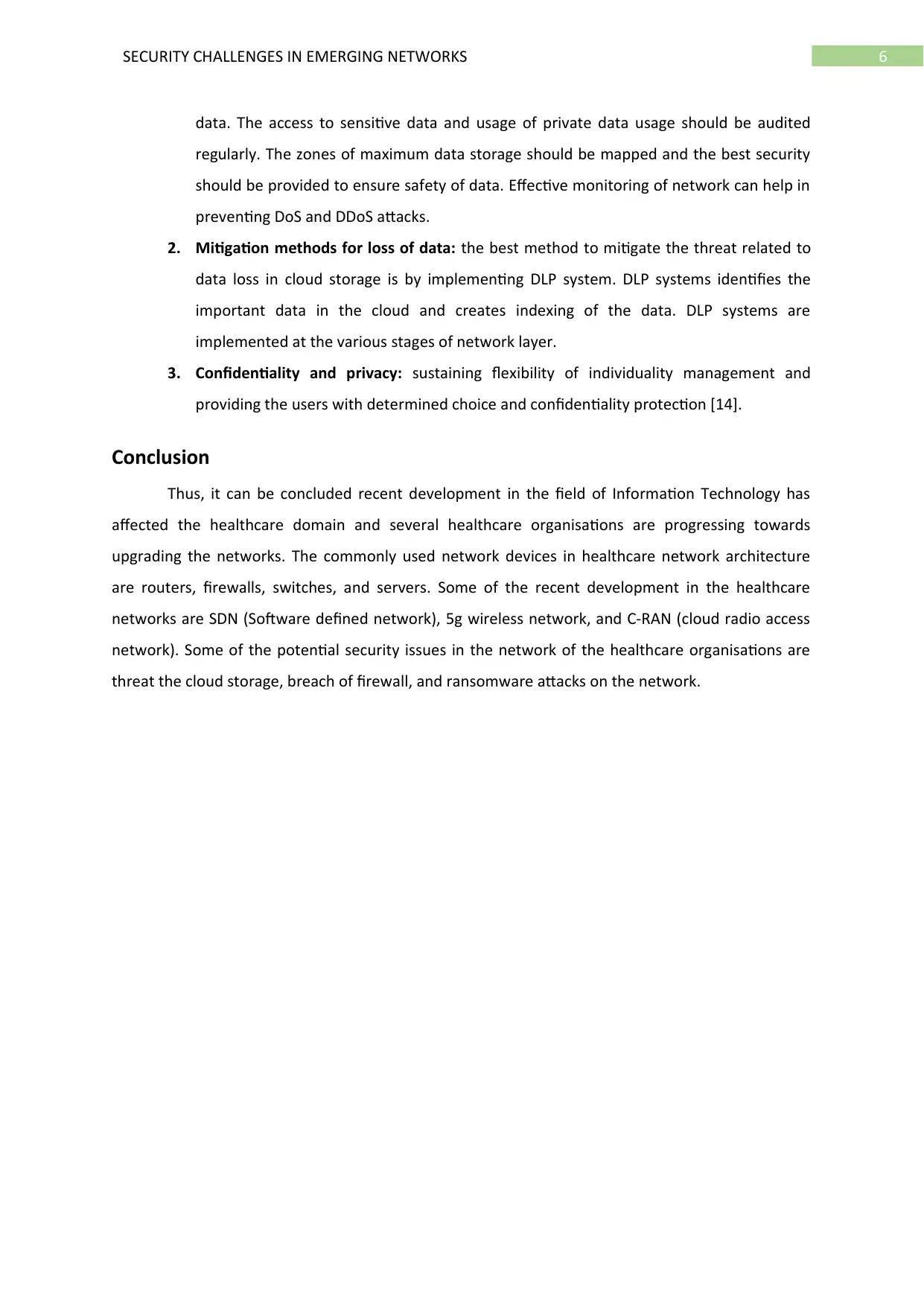
6SECURITY CHALLENGES IN EMERGING NETWORKS
data. The access to sensitive data and usage of private data usage should be audited
regularly. The zones of maximum data storage should be mapped and the best security
should be provided to ensure safety of data. Effective monitoring of network can help in
preventing DoS and DDoS attacks.
2. Mitigation methods for loss of data: the best method to mitigate the threat related to
data loss in cloud storage is by implementing DLP system. DLP systems identifies the
important data in the cloud and creates indexing of the data. DLP systems are
implemented at the various stages of network layer.
3. Confidentiality and privacy: sustaining flexibility of individuality management and
providing the users with determined choice and confidentiality protection [14].
Conclusion
Thus, it can be concluded recent development in the field of Information Technology has
affected the healthcare domain and several healthcare organisations are progressing towards
upgrading the networks. The commonly used network devices in healthcare network architecture
are routers, firewalls, switches, and servers. Some of the recent development in the healthcare
networks are SDN (Software defined network), 5g wireless network, and C-RAN (cloud radio access
network). Some of the potential security issues in the network of the healthcare organisations are
threat the cloud storage, breach of firewall, and ransomware attacks on the network.
data. The access to sensitive data and usage of private data usage should be audited
regularly. The zones of maximum data storage should be mapped and the best security
should be provided to ensure safety of data. Effective monitoring of network can help in
preventing DoS and DDoS attacks.
2. Mitigation methods for loss of data: the best method to mitigate the threat related to
data loss in cloud storage is by implementing DLP system. DLP systems identifies the
important data in the cloud and creates indexing of the data. DLP systems are
implemented at the various stages of network layer.
3. Confidentiality and privacy: sustaining flexibility of individuality management and
providing the users with determined choice and confidentiality protection [14].
Conclusion
Thus, it can be concluded recent development in the field of Information Technology has
affected the healthcare domain and several healthcare organisations are progressing towards
upgrading the networks. The commonly used network devices in healthcare network architecture
are routers, firewalls, switches, and servers. Some of the recent development in the healthcare
networks are SDN (Software defined network), 5g wireless network, and C-RAN (cloud radio access
network). Some of the potential security issues in the network of the healthcare organisations are
threat the cloud storage, breach of firewall, and ransomware attacks on the network.
Paraphrase This Document
Need a fresh take? Get an instant paraphrase of this document with our AI Paraphraser

7SECURITY CHALLENGES IN EMERGING NETWORKS
References
[1] Bhatt, Y. and Bhatt, C., Internet of things in healthcare. In Internet of things and big data
technologies for next generation HealthCare (pp. 13-33). Springer, Cham, 2017.
[2] Catarinucci, L., De Donno, D., Mainetti, L., Palano, L., Patrono, L., Stefanizzi, M.L. and Tarricone,
L., An IoT-aware architecture for smart healthcare systems. IEEE Internet of Things
Journal, 2(6), pp.515-526, 2015.
[3] Zhang, K., Yang, K., Liang, X., Su, Z., Shen, X. and Luo, H.H., Security and privacy for mobile
healthcare networks: from a quality of protection perspective. IEEE Wireless
Communications, 22(4), pp.104-112, 2015.
[4] Charani, E., Castro-Sánchez, E., Moore, L.S. and Holmes, A., Do smartphone applications in
healthcare require a governance and legal framework? It depends on the application!. BMC
medicine, 12(1), p.29, 2014.
[5] Natoli, J.D., Kermanshahche, K.M., Painter, J. and Boucher, A., Intel Corp, Healthcare semantic
interoperability platform. U.S. Patent 8,850,057, 2014.
[6] Agyapong, P.K., Iwamura, M., Staehle, D., Kiess, W. and Benjebbour, A., Design considerations for
a 5G network architecture. IEEE Communications Magazine, 52(11), pp.65-75, 2014.
[7] Jo, M., Maksymyuk, T., Strykhalyuk, B. and Cho, C.H., Device-to-device-based heterogeneous
radio access network architecture for mobile cloud computing. IEEE Wireless
Communications, 22(3), pp.50-58, 2015.
[8] Cai, W. and Shi, F., High performance SOI RF switch for healthcare application. Int. J. of Enhanced
Research in Sci., Tech. & Eng, 5(10), 2016.
[9] Khan, F.A., Ali, A., Abbas, H. and Haldar, N.A.H., A cloud-based healthcare framework for security
and patients’ data privacy using wireless body area networks. Procedia Computer
Science, 34, pp.511-517, 2014.
[10] Salehi, S.A., Razzaque, M.A., Naraei, P. and Farrokhtala, A., July. Security in wireless sensor
networks: Issues and challanges. In Space Science and Communication (IconSpace), 2013
IEEE International Conference on (pp. 356-360). IEEE, 2013.
[11] Patil, H.K. and Seshadri, R., June. Big data security and privacy issues in healthcare. In Big Data
(BigData Congress), 2014 IEEE International Congress on (pp. 762-765). IEEE, 2014.
References
[1] Bhatt, Y. and Bhatt, C., Internet of things in healthcare. In Internet of things and big data
technologies for next generation HealthCare (pp. 13-33). Springer, Cham, 2017.
[2] Catarinucci, L., De Donno, D., Mainetti, L., Palano, L., Patrono, L., Stefanizzi, M.L. and Tarricone,
L., An IoT-aware architecture for smart healthcare systems. IEEE Internet of Things
Journal, 2(6), pp.515-526, 2015.
[3] Zhang, K., Yang, K., Liang, X., Su, Z., Shen, X. and Luo, H.H., Security and privacy for mobile
healthcare networks: from a quality of protection perspective. IEEE Wireless
Communications, 22(4), pp.104-112, 2015.
[4] Charani, E., Castro-Sánchez, E., Moore, L.S. and Holmes, A., Do smartphone applications in
healthcare require a governance and legal framework? It depends on the application!. BMC
medicine, 12(1), p.29, 2014.
[5] Natoli, J.D., Kermanshahche, K.M., Painter, J. and Boucher, A., Intel Corp, Healthcare semantic
interoperability platform. U.S. Patent 8,850,057, 2014.
[6] Agyapong, P.K., Iwamura, M., Staehle, D., Kiess, W. and Benjebbour, A., Design considerations for
a 5G network architecture. IEEE Communications Magazine, 52(11), pp.65-75, 2014.
[7] Jo, M., Maksymyuk, T., Strykhalyuk, B. and Cho, C.H., Device-to-device-based heterogeneous
radio access network architecture for mobile cloud computing. IEEE Wireless
Communications, 22(3), pp.50-58, 2015.
[8] Cai, W. and Shi, F., High performance SOI RF switch for healthcare application. Int. J. of Enhanced
Research in Sci., Tech. & Eng, 5(10), 2016.
[9] Khan, F.A., Ali, A., Abbas, H. and Haldar, N.A.H., A cloud-based healthcare framework for security
and patients’ data privacy using wireless body area networks. Procedia Computer
Science, 34, pp.511-517, 2014.
[10] Salehi, S.A., Razzaque, M.A., Naraei, P. and Farrokhtala, A., July. Security in wireless sensor
networks: Issues and challanges. In Space Science and Communication (IconSpace), 2013
IEEE International Conference on (pp. 356-360). IEEE, 2013.
[11] Patil, H.K. and Seshadri, R., June. Big data security and privacy issues in healthcare. In Big Data
(BigData Congress), 2014 IEEE International Congress on (pp. 762-765). IEEE, 2014.
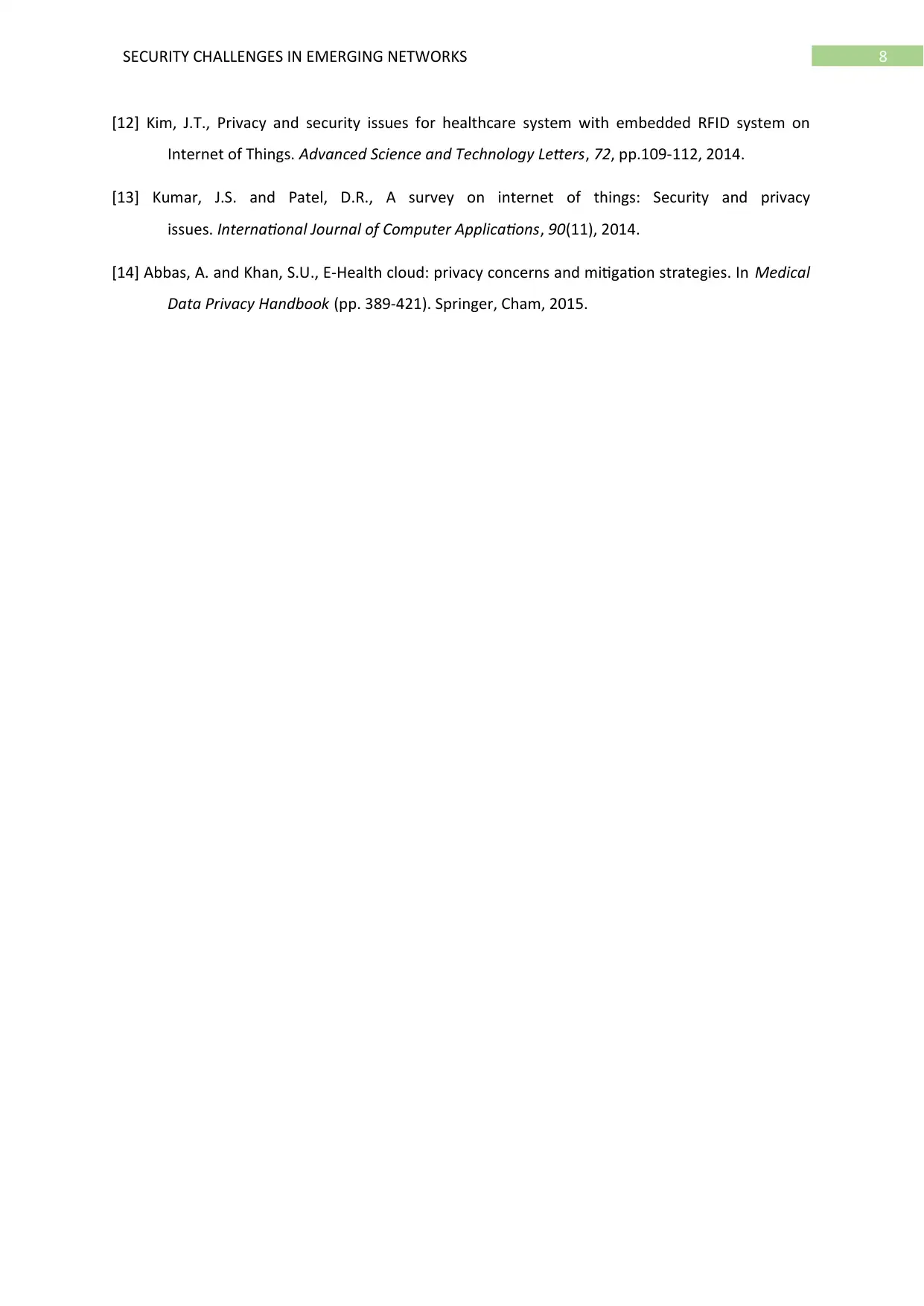
8SECURITY CHALLENGES IN EMERGING NETWORKS
[12] Kim, J.T., Privacy and security issues for healthcare system with embedded RFID system on
Internet of Things. Advanced Science and Technology Letters, 72, pp.109-112, 2014.
[13] Kumar, J.S. and Patel, D.R., A survey on internet of things: Security and privacy
issues. International Journal of Computer Applications, 90(11), 2014.
[14] Abbas, A. and Khan, S.U., E-Health cloud: privacy concerns and mitigation strategies. In Medical
Data Privacy Handbook (pp. 389-421). Springer, Cham, 2015.
[12] Kim, J.T., Privacy and security issues for healthcare system with embedded RFID system on
Internet of Things. Advanced Science and Technology Letters, 72, pp.109-112, 2014.
[13] Kumar, J.S. and Patel, D.R., A survey on internet of things: Security and privacy
issues. International Journal of Computer Applications, 90(11), 2014.
[14] Abbas, A. and Khan, S.U., E-Health cloud: privacy concerns and mitigation strategies. In Medical
Data Privacy Handbook (pp. 389-421). Springer, Cham, 2015.
1 out of 9
Related Documents
Your All-in-One AI-Powered Toolkit for Academic Success.
+13062052269
info@desklib.com
Available 24*7 on WhatsApp / Email
![[object Object]](/_next/static/media/star-bottom.7253800d.svg)
Unlock your academic potential
© 2024 | Zucol Services PVT LTD | All rights reserved.



